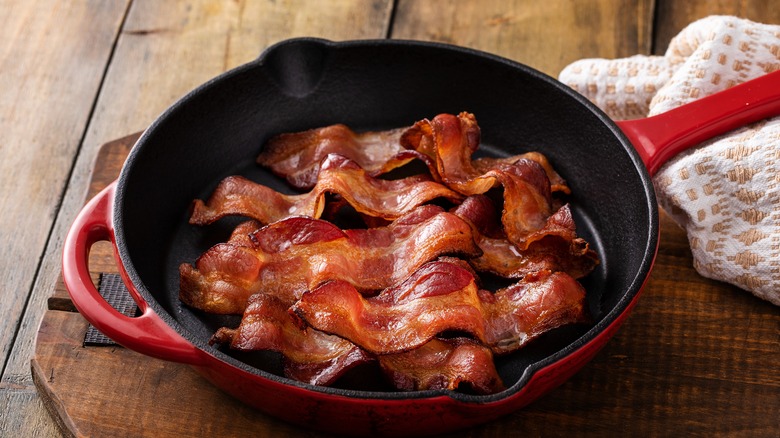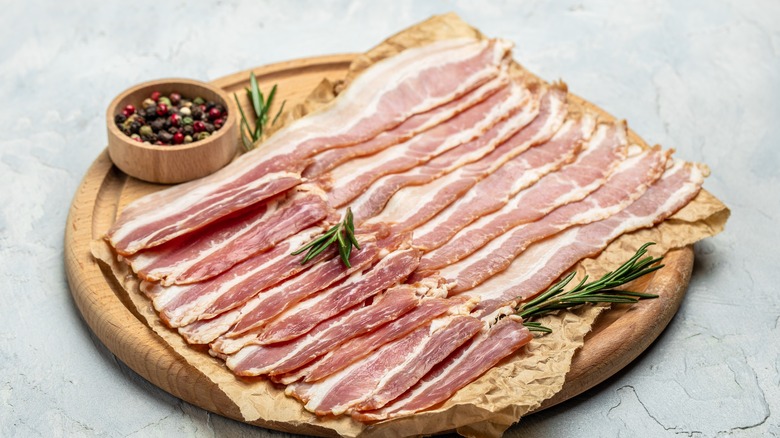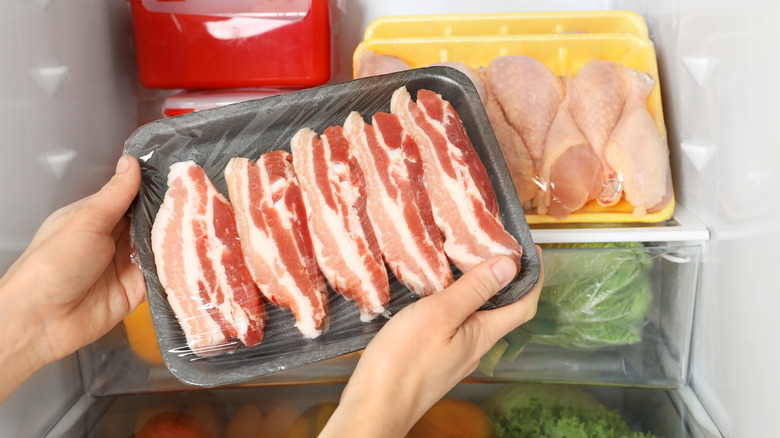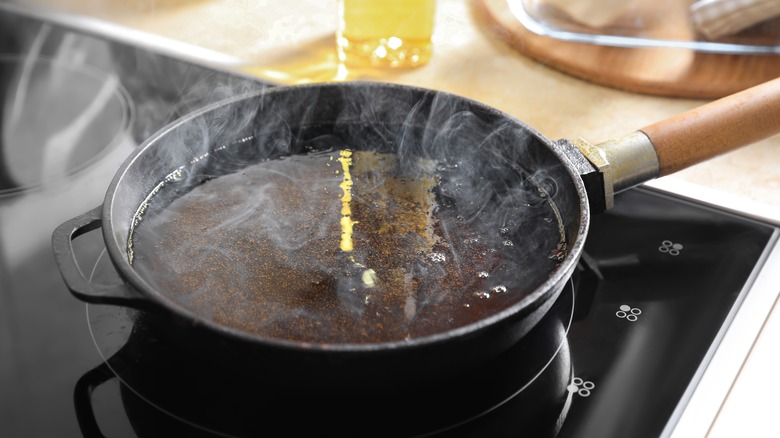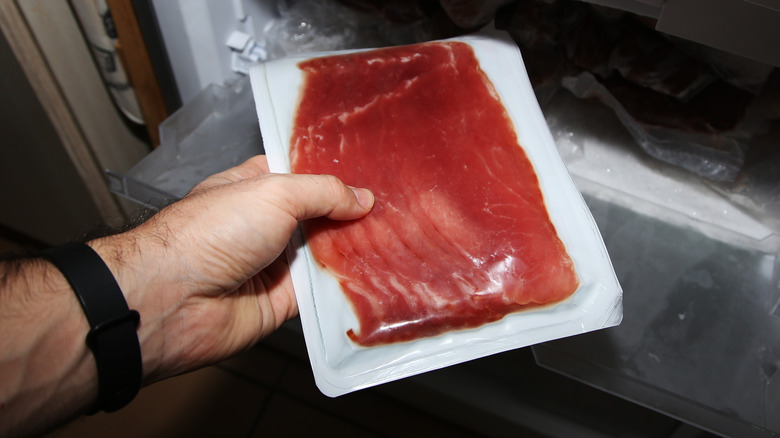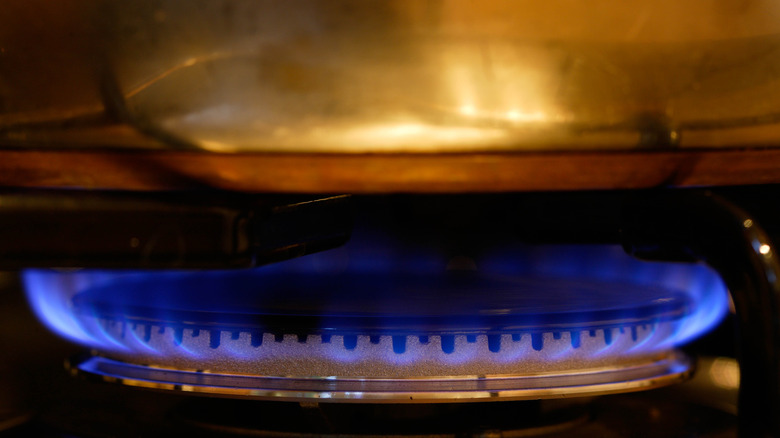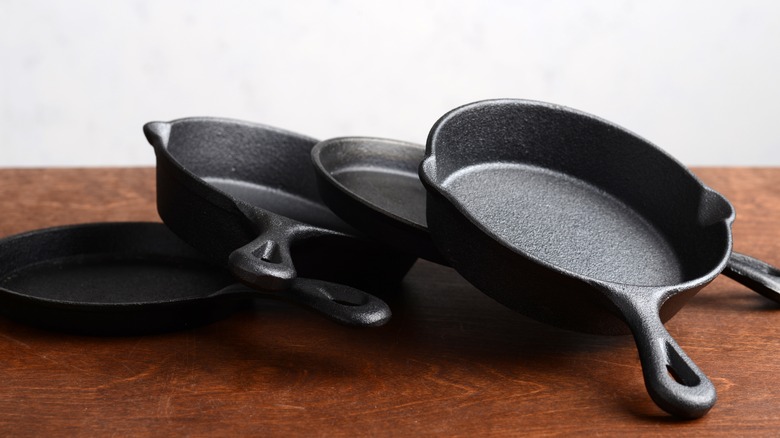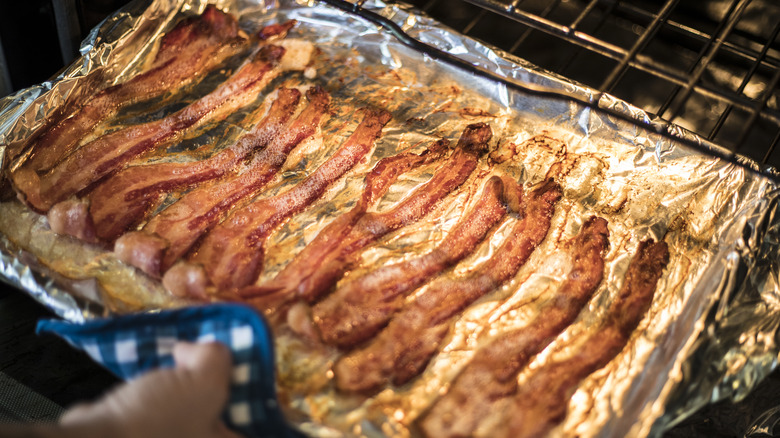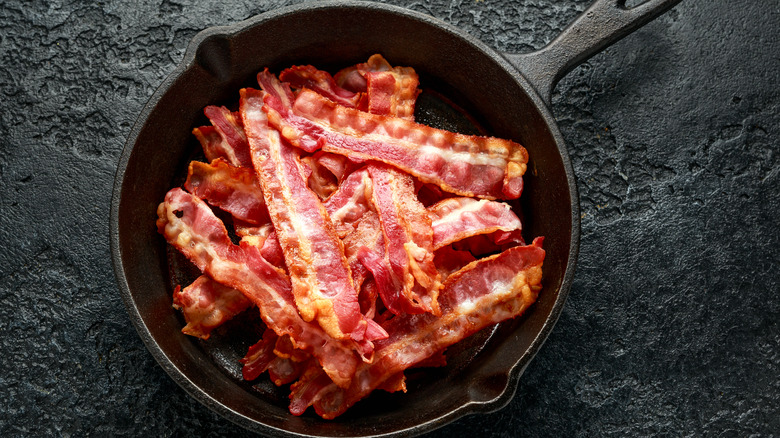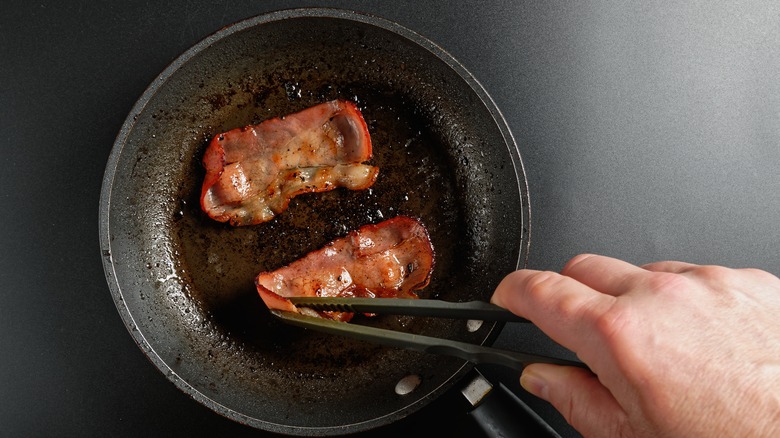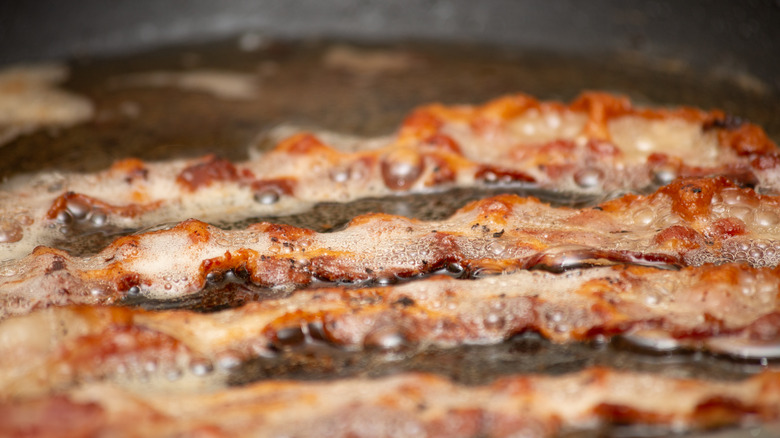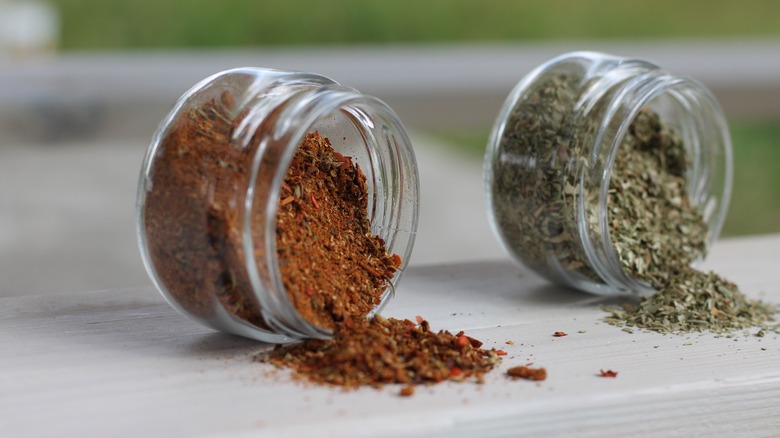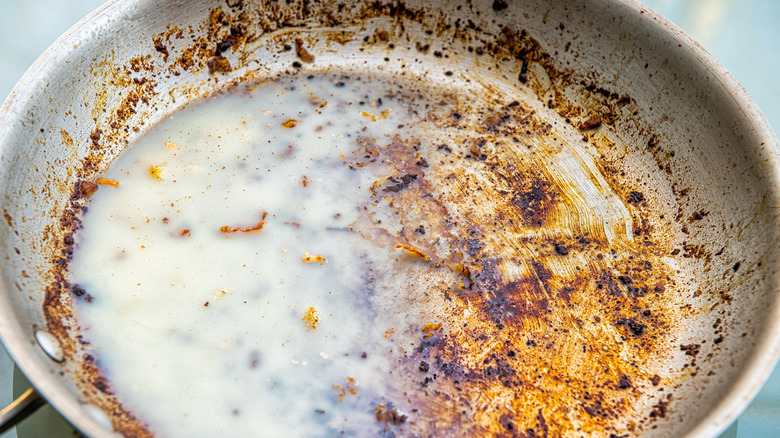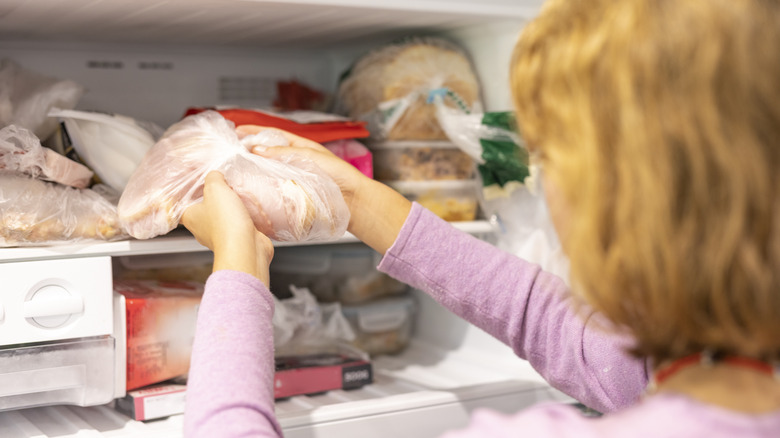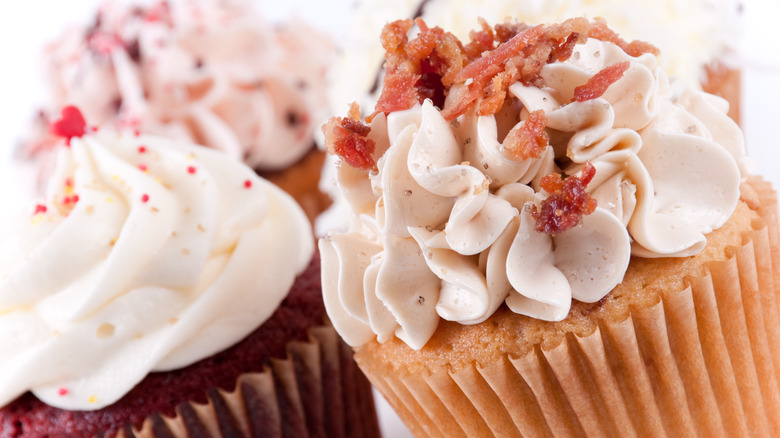These 14 Mistakes Are Ruining Your Bacon
Picture this: It's a Saturday morning and you're roused from a wonderful, restful sleep to the smell of sizzling, hot, crispy bacon. Your back doesn't hurt, cartoons are already on TV — life is good. Plus, the unforgettable scent of said bacon is distinctly savory, perfuming the air with promises of an epic breakfast. Mom always made it look so easy, but, as it turns out, a lot can go wrong when it comes to cooking bacon.
Sneaky problems can arise when cooking this favorite breakfast meat. From choosing the correct cut — never too thin, but not too thick — to using the right pan to whether or not to add water and seasoning, getting your bacon right is easier than you think if you know what mistakes to avoid in the first place. Here we've rounded up fourteen of the most common things that can go wrong when cooking bacon.
1. Opting for thin cuts
You wouldn't buy a whole chicken if you were only focused on making wings for the big game. You wouldn't grab a package of tough stew meat if you were looking into making a steak dinner. Likewise, you should understand the kind of bacon you need to buy before embarking on a breakfast endeavor.
Bacon is sold in several varieties, cuts, and smoke options. First, make sure you're choosing a thick cut of bacon — not a thin, flimsy cut. Thinner cuts taste fine but will leave you with very little after cooking. Bacon is about 50% fat, so a thinner cut will practically melt away in your pan. A great option is to buy uncured slab bacon. This is uncut bacon — the rind is still attached — made without nitrates. It's easy to find in butcher shops and specialty meat stores, plus, it can be cut to order if you wish. If you're not looking to visit a butcher counter, opt for thick-cut streaky bacon, which is the common American variety made from pork belly, cured in salt and spices then smoked over anything from hickory to pecan to applewood.
2. Keeping bacon too long in the fridge
Once you've got your perfect, thick-cut, smokey bacon in hand, there's the question of how soon you need to use it. Bacon packaging is notoriously terrible (some brands do offer a zipper-like closure, thank goodness, but many just remain open), so you will have that working against you. The best thing to do is immediately get your bacon into the fridge and not open it until you're ready to use it. Bacon will last in the refrigerator unopened until its use or best-by date. If there's no date, you can safely store the unopened bacon for about two weeks in your refrigerator before you need to use it.
If you've opened the bacon packaging, cooked some of it, and left the remainder of the uncooked bacon in the now open package, then, according to the United States Department of Agriculture, your bacon can be stored in the refrigerator for one week (at about 40 F). If you're freezing it, you can leave it in the ice box for about four months.
3. Utilizing a pan that's too hot
Now that you have your perfect bacon in hand and have stored any extra correctly, it's time to start cooking. Usually, we'd preheat an oven before putting our dish in it; or heat oil in a sauté pan before adding anything to it. Bacon doesn't play by these rules. In fact, you should never cook bacon in a scorching hot pan.
Using a hot pan for bacon will lead to a consistently inconsistent result. Because bacon has a lot of fat, adding bacon to an already-hot pan will cause the fat to start cooking immediately — and too quickly. That means that the interior of the bacon, and the fat within it, won't cook or render as fast. So you may have a really, overly crispy outside and a soggy, limp interior.
Instead, start your bacon off in a room-temperature pan. Add in your bacon and gradually get it up to heat. This will allow the fat to render slowly, and altogether the bacon will cook more consistently without giving you crispy bits and soggy bits.
4. Using cold bacon
In the same way you wouldn't want to start your bacon off in a scorching hot pan, using cold, frigid bacon directly from the refrigerator is not the way to go, either. It may seem like the easiest option to throw cold bacon into your cold pan, heating both together, but you wouldn't cook steak straight from the fridge, right? Cooking bacon straight out of its cold environment could mean undercooked fatty portions and overcooked meat portions.
Bacon is about half meat and half fat. The fat portion of your bacon is going to hold on to its chill longer than the meaty portion. So, to render the fat correctly while still crisping up the rest of the smoky strips, you should remove your bacon from the fridge and let it sit at room temperature for about 15 to 20 minutes before introducing it to your cold pan. From there, you can start the heat and cook your bacon over medium-low to medium, letting the entirety of the strip cook together at an even pace.
5. Cooking over too high of heat
Whether you're cooking over the stove, grill, or in the oven, heat makes a big difference in the quest for perfection of your bacon. When it comes to stovetop cooking, we already know that using a cold pan and starting with room-temperature bacon should help you reach the goal of perfectly crispy meat. But the temperature of your stove makes a big difference too. Starting the pan cold and shoving the heat up to high will result in the bacon's edges and exterior cooking too fast. The fat will burn and the slices will cook unevenly. Additionally, you'll likely be splattered with hot grease and your kitchen will be coated in a fine mist of bacon fat. Instead, turn your heat up to medium-low or medium at the absolute highest. This will help the bacon come to a temperature slowly and evenly cook throughout.
If you're going the oven route, the highest temperature you want to go is about 400 to 425 F. Any higher and your bacon will burn in addition to producing a cloud of smoke in your kitchen. Low and slow is one of the best ways to go — cooking around 325 to 350 F for 10 to 20 minutes will yield a well-cooked strip that's both crisp and chewy.
6. Not using a heavy bottom pan
When it comes to cooking your bacon, the vessel you'll be using does matter quite a bit. If you're going for the stovetop method — arguably the most tried and true way of cooking bacon — you need to pay attention to the quality of the pan you're using. A cardinal sin of stovetop bacon-making is using a pan with a thin bottom. For example, this is not the time to reach for the non-stick or aluminum pan that you usually use for eggs or grilled cheese. The amount of fat in bacon makes using nonstick pans superfluous, and aluminum saute pans get really hot, really fast. You'll likely be left with overly crispy, shatteringly near-burnt breakfast bacon; a travesty.
The best bet for cooking bacon on the stovetop is to reach for the trusty old cast iron skillet. The thicker bottom ensures that the bacon will cook more slowly than in an aluminum pan, and the bacon grease will aid in the sought-after seasoning of your pan. There are ways to prevent bacon from sticking to a cast iron skillet, including adding leftover bacon grease or a bit of butter.
7. Always cooking on the stovetop
Once you get the hang of cooking bacon on the stovetop in your trusty cast iron skillet, it can be difficult to break out and try any other method. But bacon can be cooked just as successfully in the oven and, yes, even in the microwave.
One of the ongoing complaints about cooking bacon on a stovetop is the splatter; the giant mess of grease splattered onto the cabinets, countertops, and, yes, even you. By utilizing a sturdy sheet pan and some parchment paper, you can cook crispy oven-baked bacon — without the mess — and for more people all at once. Preheat your oven to 400 F and spread your bacon out side by side on a piece of parchment or tin foil on top of a sheet pan. Once the oven is preheated, place the sheet pan with the bacon on it in the oven and cook for 15 to 18 minutes. Flipping is not required.
If you're pressed for time, the microwave is an option, too. While it may feel like a cop-out, microwaving can help you achieve shatteringly crispy bacon. All you need is a microwave-safe bowl and plate. If you don't have a bowl on hand, you can also cover your bacon with paper towels in the microwave. Either way, you're just a few minutes from crispy bacon goodness.
8. Crowding the pan
If crispy strips of bacon are truly what you're after (and, honestly, who isn't), then making sure your bacon has enough breathing room on its sheet pan or in its cast iron is imperative. As with cooking other meat items — like ground beef, stew meat, chicken breasts, or even salmon — you'll want to ensure that each strip of bacon has about an inch on either side. This allows the bacon to render and cook in its own space without being too close to its buddies.
If you do overcrowd your pan, you run the risk of steaming, rather than browning and cooking your bacon. Steamed bacon means limp, soggy, and overly fatty, chewy pieces instead of the crispy strips you're after. If you're using a sheet pan and going with the oven method, the same rules apply. Space your bacon at least an inch apart so you can achieve the crispy bite you're after.
9. Failure to flip
Yes, you do need to get close to and interact with that scary, bubbling grease in the cast iron pan as you cook your bacon. If you're going with the stovetop method, unfortunately, bacon is not one of those "set it and forget it" items. Once your room-temperature bacon is starting to sizzle in your pan, you'll need to grab a pair of tongs and get ready to flip it over. Bacon that is not flipped runs the risk of browning too much on one side and not fully rendering on the other.
When you hear your bacon sizzling and the fat is beginning to look translucent, grab your tongs and carefully turn each strip over — away from you — and continue to cook until your bacon has reached its desired doneness. This will ensure an even cook all over, and a better bacon experience.
If you're going with the oven route, you can flip your bacon halfway through, although it isn't necessary at all. The oven will provide a hotter environment all over, instead of just underneath each strip as a stovetop does.
10. Ignoring the water trick
If you're looking forward to utilizing bacon grease after cooking a dozen or so strips of bacon on the stovetop, this tip won't be for you. But, in recent years, adding water to your sizzling cast iron pan while cooking your bacon has become a go-to step for chefs and home cooks looking for a more even cook and for those looking to avoid the grease splatter in the kitchen.
According to Cook's Illustrated, adding water to your skillet will help make your bacon more tender in addition to getting it crispy. Place your cold pan on the stove, add in your room-temperature bacon, then add enough water to just cover the strips. Turn on the heat to high and once the water starts to boil, turn the heat down to medium. As the water evaporates, turn the heat down a bit further, to medium-low, and keep cooking until your bacon is at your desired doneness. The water will also help the bacon stay plump and juicy while the cooking after the water is gone will make your bacon crispy.
11. Skimping on the seasoning
Bacon is so flavorful that it may seem sort of counter-intuitive to add additional seasoning to it. But adding a little something to your bacon can work in its favor — not take it over the edge to flavor bomb territory. For example, adding freshly cracked black pepper to your bacon can add a savory note that you'd otherwise be missing. The earthiness of the pepper helps cut through the rich fattiness of bacon — just sprinkle on either before you heat in a pan on the stove or overtop your strips as you slide the sheet pan into the oven.
You can also go for a sweeter route with your bacon seasoning. Rub or sprinkle on a barbecue seasoning, or make your own with brown sugar, smoked paprika, cumin, and coriander right before cooking your bacon. The sugar will accentuate the meat's natural sweetness while the spices will help add lift to the overall strip.
12. Tossing the bacon grease
That bacon grease is, basically, liquid gold, so before you leave it to congeal in your pan and wipe it out and into the garbage, consider all the best ways to utilize said grease. First off, never, ever pour that bacon grease down the drain. It's way too thick and could lead to plumbing problems down the line.
The preferred way to dispose of it is to let it cool, then pour it into a container destined for the trash anyway. You can also wipe it out with paper towels and trash them. But, again, all of this would be a huge waste of a culinary powerhouse. Leftover bacon grease can be poured into a glass jar or container and stored in the refrigerator for weeks. When you're ready to use it, it can be used as a stand-in for butter in recipes for cornbread, scones, or breads. It can be used to lather onto the outside of your stovetop grilled cheese sandwiches. It can also be used to fry chicken, cook shrimp, and anywhere else you'd use oil. It can even be used in homemade mayonnaise. If you're not into the idea of bacon-flavored everything, save the grease as a fire starter for your next camping trip.
13. Forgetting to freeze your leftovers
So, you made too much bacon. It's not a world we're personally familiar with, but, we suppose you might be simply left with too many strips of bacon to eat at one time. Additionally, perhaps you got a great deal on raw bacon at the grocery store, and there's no way you'll be able to utilize it all in a week. The good news is that both raw and cooked bacon can — and should — be frozen when necessary.
Cooked bacon should be cooled on paper towels after it's removed from the heat. Line up the cooled strips on a piece of parchment or wax paper and freeze until solid. Then, you can remove them and place them all in a zip-lock bag. Cooked bacon can be frozen for about a month.
Raw bacon, meanwhile, can be placed in its unopened bag in the freezer; just wrap it in tin foil first to further defend against freezer burn. If you have an opened bag of raw bacon, remove it from the open package, place it in a zip-lock freezer bag, and freeze. Raw bacon can last in your freezer for about one to three months, depending on if the package was opened or not.
14. Bacon belongs in dessert, too
Bacon is not just for breakfast. It isn't even just for lunch or your dinner sandwiches. Bacon can and should be utilized in your desserts, cocktails, and everywhere in between. Bacon grease alone can be added to your sweeter dishes for another layer of flavor. Maybe you can grease your cinnamon bun pans with bacon grease? Or use bacon-infused butter on your breakfast scones?
If you've cooked too much bacon and are looking to use it up, a batch of chocolate chip cookies could be your answer. Bacon pairs well with the bittersweet notes in good quality dark chocolate, so when it's time to fold the chips into your cookie batter, add a couple of crumbled strips of bacon with it. The sweet and smoky juxtaposition may give you a new favorite dessert. In the same vein, you could create your favorite chocolate layer cake but add crumbles of bacon to a ganache layer for an added crunch.
